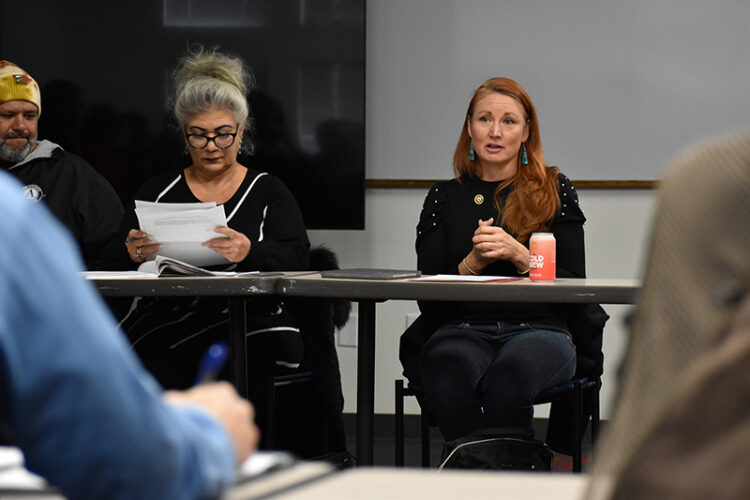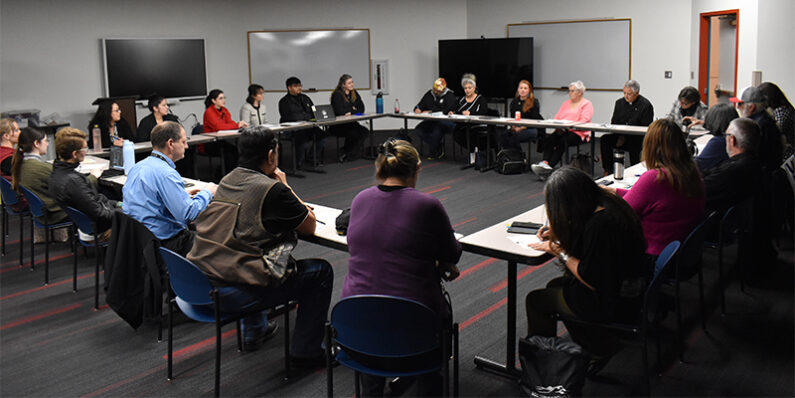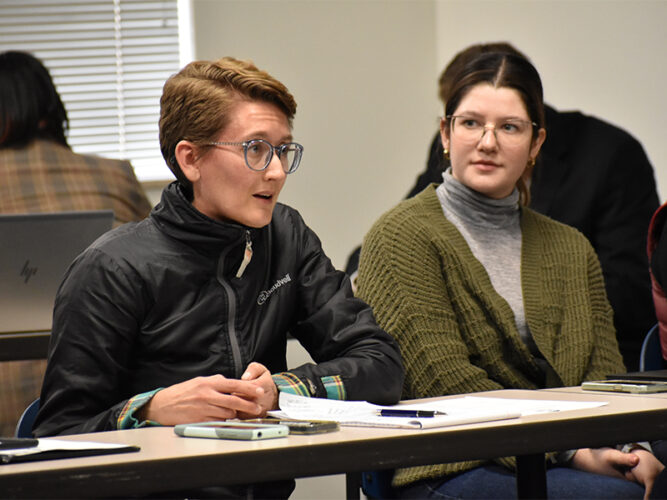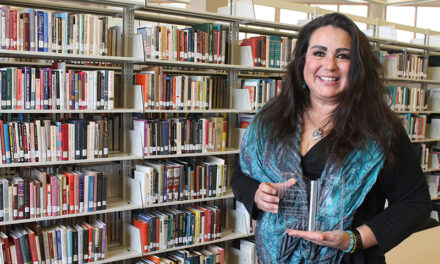TOMÉ — The housing crisis is evident in Valencia County and resources are scarce, which is why U.S. Rep. Melanie Stansbury recently met with local leaders to discuss the issue.
The round-table discussion, held Jan. 25 at the University of New Mexico-Valencia campus, had about 25 people present representing local municipalities, nonprofits and state agencies.
Stansbury represents congressional District 1 in central New Mexico, which includes parts of Valencia County. She said she’s worked on housing and homeless issues for much of her career as the issue is very personal to her.

Felina Martinez | News-Bulletin photos
U.S. Rep. Melanie Stansbury, right, speaks with community leaders about housing issues in Valencia County.
“I grew up in a low-income family myself and my family struggled at times with housing insecurity,” said Stansbury. “I think both hunger and housing insecurity are issues that so many people in our community struggle with, and a lot of times people don’t realize what it actually looks like on the ground.
“Housing insecurity and homelessness can be anything from sleeping on a family member’s couch to sleeping in a car, to people who become completely unhoused.”
The congresswoman said during recent community meetings in the county the topic that came up the most, aside from water issues, was the housing crisis and the increasing number of unhoused and homeless people in the community.
“We’re bringing all the different stakeholders together today to help identify some resources and begin the conversation and begin the journey of (identifying) whatever the solutions are that the community ultimately wants to pursue,” said Stansbury. “It’s not for us to decide; it really is up to the people of Valencia County to decide how they want to try to tackle this issue.”
Stansbury said housing in Valencia County is something high on her list for community-based funding. However, they can’t allocate funds unless there is a specific project to support that the community as a whole can unite behind.
“So help define for us what the problem looks like and your vision for how you’d like to see some of these challenges tackled,” she said.
Stansbury first heard from community members representing resource centers and nonprofits as attendees revealed there are no municipal programs, shelters or services dedicated to homelessness.
Summer Ludwig, the grant coordinator for the city of Belen and chairwoman of the Democratic Party of Valencia County, said she and the folks at the Community Advocacy Team, a local nonprofit, have worked directly with people experiencing housing insecurity and homelessness.
“What you come across is there’s such a strong resistance from community members and leadership to do anything to help the homeless folks that we see,” said Ludwig.
“There’s a lot of stereotypes that Albuquerque is bussing folks down; however, we have found through actually talking to them that’s not the case. They are Valencia County folks and they are in crisis, and we are ignoring it.”
Ludwig said there’s several good agencies in the county doing “little bits and pieces” to help where they can, but there is a lack of a cohesive solution.
“So I really would like to see a coalition of all of our local governments come together and to seriously take up the subject, which had just sort of started, but we haven’t had those meetings for a long time,” said Ludwig.
“There’s always this us versus them mentality,” she continued, “and if we continue to ‘other’ folks who are experiencing homelessness, it’s only going to get worse and worse.”
Former Rio Communities municipal judge Holly Noelle Chavez, recognized in the community for her charitable work, also shared her insights.
“We have come across unaccompanied homeless youth and seniors who did everything right, and then due to no fault of their own, they can no longer keep up with the payments of rent or their mortgage and are now sleeping in cars,” she said.
Chavez proposed conducting a feasibility study with those experiencing homelessness to get insight on what services shelters could provide that would be most helpful to them.
“They are not from other counties; they are our people,” she said. “If we can hear their voices and give some choice in the services they can receive, I think we can make a long term impact on the culture of our community.”

The round-table discussion, held Jan. 25 at the University of New Mexico-Valencia campus, had individuals present representing local municipalities, nonprofits and state agencies.
Andrea Padilla, president of the town of Tomé Land Grant, emphasized the multifaceted nature of the issue.
“It’s the affordability; it’s mental health and drug addiction. It’s landlords that think their houses are made out of gold,” said Padilla.
Pamela Skinner, representing the Community Wellness Council, said partnership is key for addressing an issue like this and there is a definite need for a housing authority and rural development presence in the county.
Skinner said inclusionary zoning is also something that should be considered.
“They’re building all these big, beautiful monster houses here and inclusionary zoning tells them for every so many you build this big, you have to build affordable housing over here somewhere,” said Skinner. “We need to put that back into effect in Valencia County or we’re going to become like Santa Fe, where people from here are not going to be able to afford to live here anymore and get pushed out.”
Camille Griego, representing the Los Lunas Schools McKinney Vento program, said a significant obstacle is also the lack of consistent, short-term solutions, such as emergency rapid housing or emergency shelter vouchers.
Stansbury then heard from some representatives of local municipalities.
Los Lunas deputy village administrator Erin Callahan said the village does not have any new affordable housing developments because it’s been complicated to make them happen.
“We are under contract right now with an affordable housing developer but, for the past two years, he’s struggled to get his financing off the ground that he thought was going to be a no-brainer,” Callahan said.

Los Lunas deputy village administrator Erin Callahan, left, explains the housing issue within the municipality boundaries.
She said there is also hesitancy from elected village officials to approve new affordable housing projects because there’s hesitancy from their constituents.
“Our multi-family housing stock in Los Lunas is old and is getting pretty rundown, and there’s a lot of crime there, so there’s a real perception on the part of neighbors at this point to say, ‘we don’t want another one of these projects here, because look at what happens,’” said Callahan. “Though I don’t think that that’s what the outcome is anymore. The projects that come in today, they’re very different and we’re looking for very different types of outcomes.”
Callahan said there are also no market rate apartment complexes being built in the village because the developers can’t secure financing due to the lack of comparable developments in the area to help support the projects.
After hearing from the group, Stansbury agreed a feasibility study for the area is a good idea because updated statistics and more information is needed and a survey may help local leaders in forming a path forward.
“We need to do an assessment of how to build out the long-term housing and to deal with the acute challenges because we’re hearing that the charitable organizations are already overwhelmed,” she said.
Stansbury also advised building on existing community organizations and where there’s already natural leadership in the community as “sometimes it makes more sense to scale up existing grassroots things versus building one big, formal thing.”
“But it’s federated under a larger structure, which enables the federal and state agencies to bring more money in,” said Stansbury. “And this goes with the resource problem, so you’re not competing, you’re federated, and filling different roles in different communities.”
After offering up possible pathways and suggestions, Stansbury asked the group to work together on creating some sort of proposal for what’s needed. She said once something specific is put forth, federal and state entities can then aggressively pursue funding to begin building something out.
With next steps established, Stansbury said she will be back in early April to check in on what progress has been made.
Felina Martinez was born and raised in Valencia County. She graduated from the University of New Mexico in 2021. During her time at UNM, she studied interdisciplinary film, digital media and journalism. She covers the village of Los Lunas, Los Lunas Schools, the School of Dreams Academy and the town of Peralta.

















